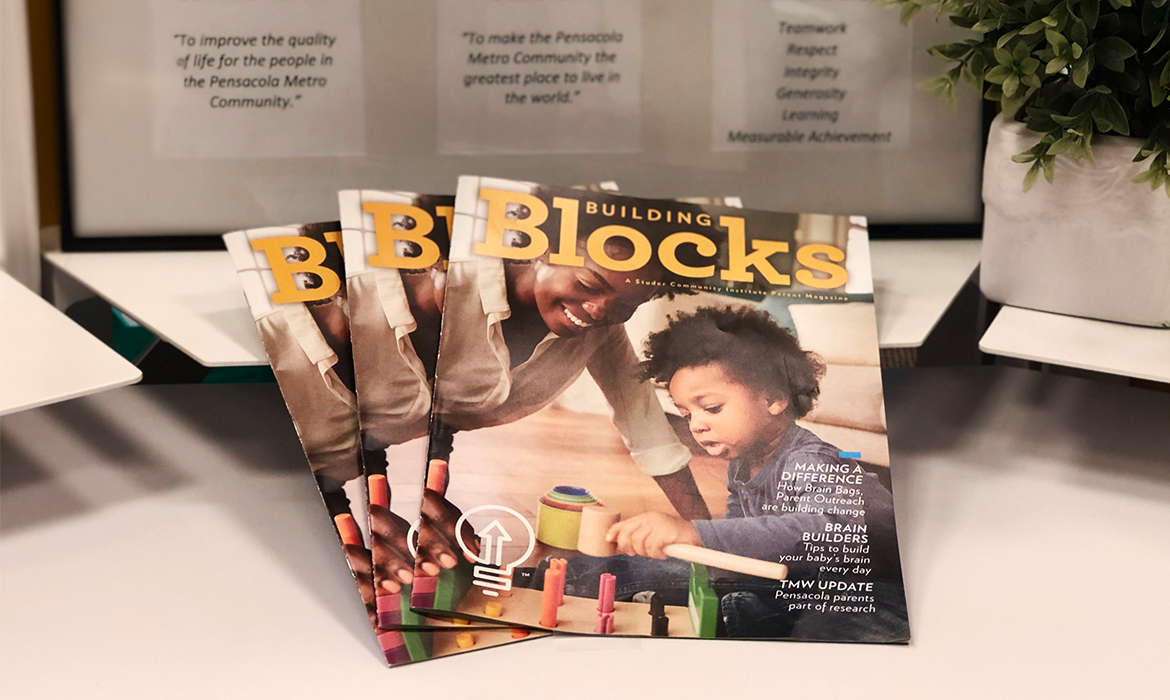'Building Blocks' give parents tools to help build babies' brains
- January 17, 2019
- / Reggie Dogan
- / early-learning

Building Blocks are fun for children, but they also are brain builders that help little ones learn and develop their skills.
The Studer Community Institute’s “Building Blocks” magazine is a similar tool for adults: It’s fun, informative and helping in showing how to help their babies grow and reach their fullest potential in life.
Building Blocks’ second edition now is available for the community’s reading and learning pleasure — complete with important and useful information to help babies, toddlers and children reach and exceed developmental milestones.
The 34-page publication provides valuable tips, useful guides and innovative information to engage and involve parents in their young children’s lives.
But it’s not just for parents. It’s beneficial to the entire family and beyond.
The phenomenon of grandparents and other relatives raising children is nothing new. Research, in fact, shows the number of children being raised by someone other than a parent has increased considerably over the last 25 years. Grandparents, family members and caregivers alike can find some useful tips and tools on how talking to and engaging with babies and toddlers can help develop their tiny brains.
“The first 1,000 days of a baby’s life — from birth to 3 years old — are a crucial window for how his or her brain will grow,” says Shannon Nickinson, SCI director of early learning. “Relationships with parents and caregivers are crucial as the brain develops, and we hope this magazine provides some useful information to help.”
Building Blocks and early childhood education are complementary. Block building has always been an integral part of educating young children by integrating the concepts of playing and learning.
From infancy, children enjoy blocks. Babies like touching, gripping and banging blocks together. Then, toddlers attempt to build structures and begin imaginative play.
Toddlers and preschoolers love playing with blocks. In addition to developing motor skills and hand-eye coordination, block play can also help foster creativity, enhance problem-solving ability and build other cognitive, emotional and social skills.
A recent study tracked a group of students from preschool through high school. Students who played with blocks in complex ways as preschoolers scored higher on standardized tests and showed greater proficiency in math class — in particular, Algebra in middle school.
“Building Blocks” can benefits parents and adults as well. The magazine, in a two-page spread, highlights the Pensacola Metro Dashboard, which lays out objective benchmarks that measure and gauge progress and identify key areas that need improvement.
Building Blocks also covers an array of interesting, informative and educational topics designed to help parents and caregivers understand the importance of talking and engaging with children to build strong brains and better lives.
The information and articles are centered around SCI’s mission to improve the quality of life through early education. They explore, examine and explain SCI initiatives and programs, including Brain Bags, Parent Outreach, LENA GROW, Make Play Smart and an Thirty Million World update.
Provided by Florida State University College of Medicine, “The First Words Project” offers parents resources to help guild a child’s development, focusing on 16 gestures by 16 months. It includes an informative display of ASQ’s (Ages & Stages Questionnaire) used by health care professionals, child providers and developmental experts to track a child’s growth over his or her first three years.
Research shows the development of gestures predicts language skills two years later. Children should be using at least two gestures each month from 9 to 16 months old. By 16 months, child should have at least 16 gestures.
Building Blocks didn’t overlook its most important reader: the child. Included in the magazine is a Developmental Checklist that provides signposts to help track a child’s healthy development. The two-page chart display, from the Centers for Disease Control and Prevention, can help parents know what to look for in the first three years of a child’s life.
Building Blocks is one of several projects that Studer Community Institute has that aims to improve the quality of life and increase kindergarten readiness in the community.
“Our passion is to make our community the best place to live and raise a family,” Nickinson said. “To us, that means giving parents, grandparents, aunts and uncles a deeper understanding of how important the first three years of life are to a child’s intellectual and emotional development.”
 CivicCon launches with a look at good growth in cities
CivicCon launches with a look at good growth in cities
 Building stronger brains one baby, one parent at a time
Building stronger brains one baby, one parent at a time
 SCI debuts commercial on Early Learning City
SCI debuts commercial on Early Learning City
 Entrecon: World class speakers and an opportunity to sharpen skills
Entrecon: World class speakers and an opportunity to sharpen skills
 PYP Quality of Life survey 2017
PYP Quality of Life survey 2017
 EntreCon Pensacola 2016: A look back
EntreCon Pensacola 2016: A look back
 Leadership tip: getting better employee takeaways
Leadership tip: getting better employee takeaways
 Leadership tip: be interested instead of interesting
Leadership tip: be interested instead of interesting
 Leadership tip: delivering difficult messages
Leadership tip: delivering difficult messages
 Brain Bags boost Arc, Early Childhood Court programs
Brain Bags boost Arc, Early Childhood Court programs